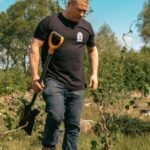A Friend to Wildlife
The Spindle is a true ally of biodiversity. Its small, pale flowers appear in late spring, offering nectar for bees, hoverflies, and other pollinators. As the seasons shift, its seeds ripen into bright, eye-catching fruits that provide food for robins, starlings, and other berry-eating birds, who then help spread the seeds far and wide.
Its dense branches also create safe nesting cover for birds and shelter for small mammals. By sustaining life through multiple stages of the year, the Spindle quietly supports the rhythm of Ireland’s ecosystems.
A Natural Connector
Beyond its charm, the Spindle plays a vital environmental role. Its roots help bind the soil, preventing erosion along banks and fields. In hedgerows, it acts as a connector species, linking habitats and allowing wildlife to move safely between them. Its leaves and bark support various insect species, including several moth larvae, contributing to the food web that keeps the countryside thriving.
Every Spindle tree helps strengthen the natural corridors that sustain biodiversity across Ireland. It’s one of those trees that holds the ecosystem together, subtle, steady, and essential.
A Tree with Craft and Character
The Spindle has a long and colourful history. Its wood is exceptionally hard, smooth, and fine-grained, traditionally used for making spindles to spin wool, which is how it earned its name. Craftspeople also prized it for fine carving and tool handles, where precision and strength were essential.
In Irish and European folklore, the Spindle was sometimes seen as a symbol of fate, representing the threads of life woven together in the great tapestry of nature. It reminds us that every living thing plays its part in the pattern of the world.
Weaving the Threads of Life
When you help plant a Spindle with Grown Forest, you are joining the effort to weave a more connected, biodiverse Ireland. You’re adding a tree that feeds birds, shelters wildlife, stabilises soil, and lights up the landscape each autumn.
Spindle teaches us that every species, no matter its size, has an important part to play. Together, these trees create a living network that protects, nourishes, and renews the land. One small act, one planted tree, becomes part of something much larger, a forest stitched together with care, colour, and life.

